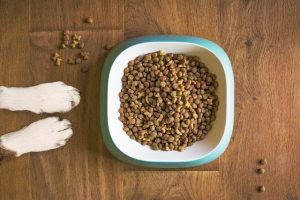1. Forget About The Marketing
Never fully place your trust in the marketing hype. Brands have a job to sell their product. Because of this, you cannot place total faith in what they are saying about their product. Relying on the marketing on the packaging for nutritional information isn’t optimal.
Anyone that is creating those advertisements or marketing material isn’t behind formulating the food. They don’t necessarily care what’s in the food, their entire purpose is to sell it. Therefore, you’ll want to thoroughly examine the labels on the dog food to ensure you are making the most informed decisions regarding the food you buy.
You will find that dog food products always list the ingredients in order based on the quantity in the food. Because of this, you’ll want to stick to researching the most prevalent ingredients. You can look at the first five ingredients and research them on Google. Type in the ingredient and “bad for dogs” and “good for dogs” and you’ll be able to see what ingredients you want to avoid. You may be surprised by the results.
There is a good reason I am fully against prescription food for dogs. While they may help with a specific condition, they are generally going to cause a lot of other problems. That’s not even factoring in the cooking process or the packaging.
You want to speak with whoever is recommending the products and ask about the nutritional content. Try to get them to detail what the ingredients are and why they are in the food. Then, you can conduct your research and figure out whether or not to feed your dog the food. Having a dog treat tin is an excellent way of storing their treats, and great for travel too.
2. Don’t Feed Shelf-Stable Foods As a Staple
There are a lot of things to look out for when you are trying to identify the right dog food to get. One thing you need to do is avoid making anything shelf-stable a staple of your diet. Due to plenty of creative marketing people, a lot of consumers typically overlook why processed foods are bad for dogs and even humans. There is a reason these foods have a 12 to 24-month shelf life and it’s generally not good for you.
Marketing has continued to condition consumers that shelf-stable foods are good for dogs and provide all of the nutrition they need to keep their dogs healthy.
Unfortunately, it’s the opposite. While there are always exceptions, these foods are typically not good at all for your dogs. These ingredients do not have any live enzymes in them. Because of this, they don’t have nutrient value. They are effectively “dead” foods that rely on supplementation to attach the “balanced” nutrition moniker they have on the labels.
The biggest problem with these products isn’t the fact they exist, but with how they are marketed. They are being marketed as a substitute staple for a dog’s diet. However, they aren’t even close to fulfilling it.
You could always synthetically pack all kinds of nutrients into a can and call it nutritionally balanced for humans and promote it as a staple diet. The fact is, it’s not and it shouldn’t be advertised or marketed in such a manner.
While these foods certainly have their place in the market, they shouldn’t be sold as a replacement for actual food. Canned foods, biscuits, and kibble have their place when used in shelters, on long trips, and more. They simply shouldn’t be used as an alternative staple for a dog’s diet.
3. Add Whole Foods
One of the most important things you can do for your dog(s) is to add whole foods to their diet. You will find fresh whole foods like fruits and vegetables are healthy options for your dog. They contain the healthy and living enzymes your dog needs to optimise their health.
These foods are full of fibre which can help with digestive health. These foods contain a lot of nutrients that make it easier for your dog to relieve themselves and for them to feel energised.
A lot of the nutrients found in shelf-stable foods are completely killed off throughout the cooking and prepping process. Because of this, manufacturers are forced to supplement these foods with synthetic nutrients.
These nutrients are synthetic which means they aren’t equally as bioavailable as natural nutrients. Thus, there is a big difference in the nutritional properties of each. Whole foods contain the requisite nutrients that can work seamlessly together to effectively help the body absorb and use all of the nutrients. Not only is “you are what you eat” a factual statement, but you are also “what you can absorb.”
You need to conduct your research when you are looking for safe whole foods for dogs. It’s important to understand some whole foods are bad for dogs. Some are poisonous and should be avoided. You will also be amazed at the different parts of vegetables that are most advantageous for dogs. For instance, the stems of the broccoli leaf contain a lot more than the head.
One of the best ways to serve vegetables to your dog is by pureeing them. This can help break down the cell walls and make it much easier to adsorb. You could also feed these vegetables whole to help their teeth and gums.
